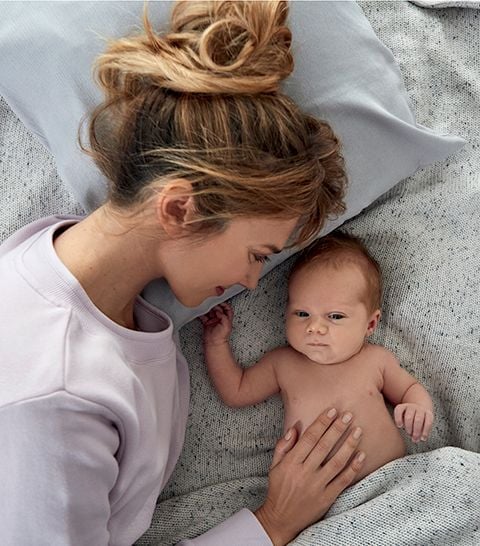Why Dressing Your Baby for Sleep Matters
Before we delve into the specifics, let's understand why dressing your baby for sleep is so important.
- Temperature Regulation: Babies can't regulate their body temperature as effectively as adults. Dressing them appropriately for sleep helps maintain a comfortable body temperature throughout the night.
- Safety: Overheating is a Sudden Infant Death Syndrome (SIDS) risk factor. Proper sleepwear choices can reduce this risk significantly.
- Comfort: A comfortable baby sleeps better, and that means better sleep for parents too!

Swaddling Your Baby to Sleep
If your little one is an infant up to four months of age, swaddling them would be the perfect choice. This comfy bundling technique resembles a mother’s womb and makes them feel safe and soothed. Using a lightweight and breathable fabric such as cotton or muslin will offer you ample flexibility to easily wrap and tuck your little bundle of joy.
Once the baby learns how to roll over, it’s time to lose the swaddle as it is no longer safe. This technique restricts your little one’s hands and feet movement, so they won’t be able to roll back over. Switching to onesies or a two-piece pajama set will allow more freedom and comfort to your growing munchkin.
That said, if you’re a newly minted parent who wants to learn more about swaddling: the when, how, why, and other tips, read our comprehensive guide for detailed tips and a step-by-step guide.
Choosing the Right Sleepwear
Now, let's explore the key factors to consider when choosing sleepwear for your baby.
Fabric Matters
- Opt for soft, breathable fabrics made from natural fibers. Sleepwear made from cotton is an ideal choice throughout the year. It proves to be effective in both hot and cold weather. During summers natural fabrics will absorb sweat and pull moisture away from your baby’s body. While in winter, they provide insulation and are easier to layer. Silk, wool, cashmere, hemp, and linen are good alternatives to look out for.
- Avoid rough or scratchy materials that could irritate your baby's sensitive skin. Fabrics with sequins or embellishments can leave rashes and cause itchiness.
- Avoid any sleepwear with ribbons, ties, strings, or anything else that your baby might get tangled up in. While these details look adorable for photoshoots, they are not safe to be slept in.
Consider the Season
Adjust your baby's sleepwear based on the weather. In colder months, use layers to keep them warm. In warmer months, opt for lightweight, breathable options.
Check the Fit
Ensure that sleepwear fits snugly but not too tight. Loose fabric can pose a suffocation hazard, while overly tight clothing can be uncomfortable.
Keep things functional
When dressing your baby for sleep, remember that you’re likely to perform a few diaper changes throughout the night. This means convenience should be prioritized for you and your baby. Sleepwear with strategically placed snaps and zippers will make the 3 a.m. diaper duty a little less daunting.

Dressing Your Baby for Different Sleep Environments
Warm Weather
Keep it light and breezy on warm nights with a short-sleeve cotton bodysuit or t-shirt with a muslin swaddle. If the temperature is sweltering, a bodysuit or a tee on its own will do as well. However, if you are regulating the room’s temperature with the air conditioner, stick with long-sleeve pajamas with footies. For the little ones who have grown out of their swaddling stage, choose a short-sleeved pajama set.
Cold Weather
Overdressing your baby for winter is a common problem. It is best to layer their outfit for easy removal in case they are feeling hot. Start with a onesie or a body suit as a base layer. Then add footed pajamas to keep them warm. While this is sufficient for winters in the region, you can top it off with a wearable blanket or swaddle if you are traveling to colder countries.
Monitoring Your Baby's Comfort
-
Touch Test: If your baby is feeling uneasy even after being fed and changed, they might be feeling too hot or too cold. Physical indicators such as rashes, wet hair, red cheeks, quickened breathing, and perspiration signal that your little one is potentially overheating. Feel your baby's neck, back, tummy, or chest to gauge their temperature. They should feel warm, not hot or sweaty. You can reduce the temperature by removing a layer or turning on the AC. While overheating is a common and bigger concern in the region, it is also important to check if your little one is not too cold. If their hands or feet are looking slightly blueish, you can add another layer to keep them warm.
-
No to Hats Indoors: Remove any hats or hoods when your baby is sleeping indoors to prevent overheating. Also, avoid any loose articles in their sleeping area. A hat might slip off their head and cover their face, restricting proper breathing.
-
Use a Room Thermometer: Keep the room at a comfortable temperature, ideally between 20°C to 22°C (68°F to 72°F).

Mamas & Papas Sleepwear Recommendations
Now that you have a better understanding of how to dress your baby for sleep, consider exploring Mamas & Papas' wide range of baby sleepwear options. Our products are designed with your baby's comfort and safety in mind. From soft and breathable onesies to pajama sets, we have everything you need to ensure a peaceful night's sleep for your little one.
Dressing your baby for sleep is a vital aspect of parenting that directly impacts your baby's comfort and safety. By choosing the right sleepwear, monitoring their comfort, and maintaining an ideal sleep environment, you can help your baby sleep soundly through the night. Remember, a well-rested baby is a happy baby, and Mamas & Papas is here to assist you every step of the way. By following these guidelines and utilizing Mamas & Papas' products, you can ensure your baby sleeps comfortably and safely, allowing you to enjoy those precious moments of parenthood even more.









